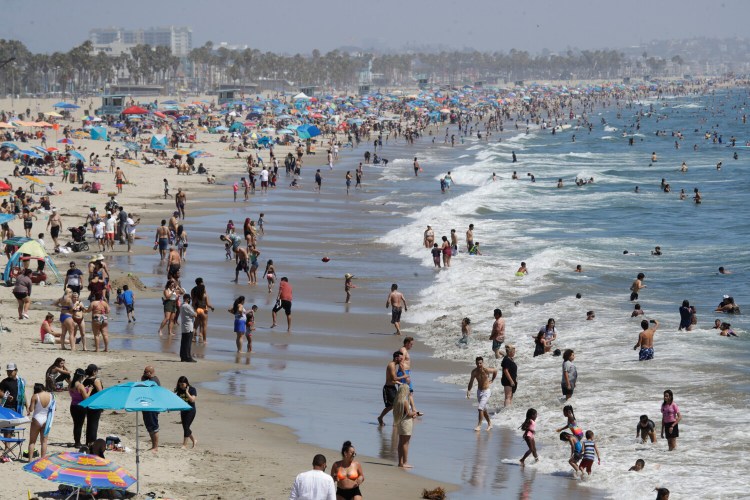As many as 2 million Californians were plunged into darkness over a four-hour span late Friday in the state’s first rolling blackouts since the 2001 energy crisis – and that was just Day One.
A heat wave is expected to blanket California through the middle of next week, sending temperatures soaring past 110 degrees Fahrenheit in some areas and raising the specter of more power cuts to ease strain on the electricity grid.
The high in Sacramento is forecast to hit 108 on Saturday. Los Angeles will be 97. Even San Francisco, famous for its cool summers, will be in the upper 80s.
The sudden and largely unannounced outages in California are a stark reminder of the fragility of power grids in the face of extreme weather. Searing heat has gripped cities around the globe in recent weeks, including Brussels, Paris and New York. Earlier this month, violent winds in the U.S. Midwest and a tropical storm in the Northeast left millions with power, in some cases for as much as a week.
The outages in California started at about 6:30 p.m. on Friday, when the state’s grid operator determined through a complex calculation that power reserves had fallen below a critical threshold and called a Stage 3 grid emergency, which triggers what it describes as “load interruption.”
The last time such a declaration was made during the electricity crisis of 2000 and 2001, hundreds of thousands of homes and businesses took turns going dark, power prices surged to a record and the state’s largest utility was forced into bankruptcy.
“We had an energy shortfall,” Anne Gonzales, a spokeswoman for grid manager California Independent System Operator, said in a phone interview late Friday. The agency put the call out to the state’s utilities to cut demand by about 1,000 megawatts. That’s enough to power about 750,000 homes, by California ISO’s estimates, affecting more than 2 million people based on the average household size.
The heat and the blackouts are hitting at an especially vulnerable time for the region with COVID-19 forcing people to remain at home. Less than a year ago but before the pandemic, regional utilities deliberately cut off power to millions of customers in an effort to prevent their power lines from igniting wildfires amid unusually strong winds – another consequence of increasingly extreme weather brought on in part by climate change.
Regions around the world have been grappling with extreme heat, including parts of Europe and the eastern U.S., where temperatures last month were expected to set records for New York and Boston.
Last month was tied for the world’s second-hottest July on record and the hottest ever in the northern hemisphere, according to the National Oceanic and Atmospheric Administration. But few authorities, if any, resorted to rotating outages.
The bulk of the shutoffs came from PG&E Corp. The state’s biggest utility said it expected as many as 250,000 customers to be shut off in rolling outages.
“Unfortunately, because of the emergency nature of this, we weren’t able to notify customers in advance,” Jeff Smith, a company spokesman, said by phone. The outages occurred for 60 to 90 minutes on a rotating basis through the utility’s Northern and Central California service territory, he said.
Edison International’s Southern California Edison utility began shutting off customers shortly before 7 p.m., with about 132,000 powerless as of 7:45 p.m.
Sempra Energy’s San Diego Gas & Electric utility said shutoffs were “widespread” across its territory in San Diego and southern Orange counties.
Temperatures climbed to a record in parts of the Bay Area on Friday, according to the National Weather Service, with San Francisco reaching 95 degrees Fahrenheit and San Jose at 103.
Electricity prices already hit two-year highs as weather forecasters called for extreme temperatures. Spot power prices surged past $1,000 a megawatt-hour across California on Friday evening. Natural gas prices in Southern California more than doubled on the increased need for the fuel for power production, BloombergNEF reported.
Grid operators will monitor the situation throughout the weekend and into next week, Gonzales said. The odds of rolling outages on Saturday and Sunday might prove lower as demand is typically weaker outside of work hours.
“We don’t expect one, but we are prepared for one,” California ISO’s Gonzales said.
Send questions/comments to the editors.



Success. Please wait for the page to reload. If the page does not reload within 5 seconds, please refresh the page.
Enter your email and password to access comments.
Hi, to comment on stories you must . This profile is in addition to your subscription and website login.
Already have a commenting profile? .
Invalid username/password.
Please check your email to confirm and complete your registration.
Only subscribers are eligible to post comments. Please subscribe or login first for digital access. Here’s why.
Use the form below to reset your password. When you've submitted your account email, we will send an email with a reset code.